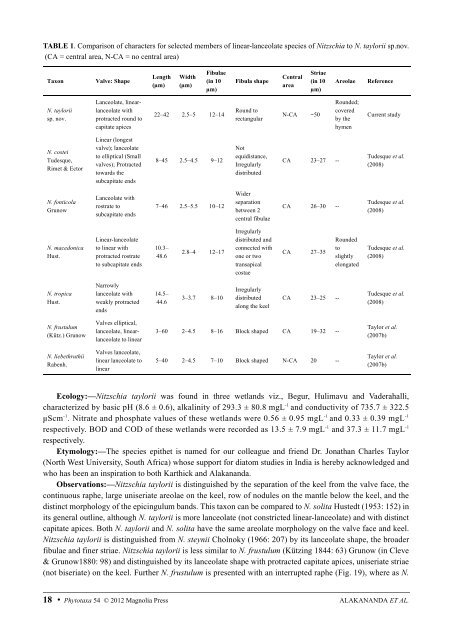Two new species of Nitzschia (Bacillariophyta) from ... - CES (IISc)
Two new species of Nitzschia (Bacillariophyta) from ... - CES (IISc)
Two new species of Nitzschia (Bacillariophyta) from ... - CES (IISc)
Create successful ePaper yourself
Turn your PDF publications into a flip-book with our unique Google optimized e-Paper software.
TABLE 1. Comparison <strong>of</strong> characters for selected members <strong>of</strong> linear-lanceolate <strong>species</strong> <strong>of</strong> <strong>Nitzschia</strong> to N. taylorii sp.nov.<br />
(CA = central area, N-CA = no central area)<br />
Taxon<br />
Valve: Shape<br />
Length<br />
(µm)<br />
Width<br />
(µm)<br />
Fibulae<br />
(in 10<br />
µm)<br />
Fibula shape<br />
Central<br />
area<br />
Striae<br />
(in 10<br />
µm)<br />
Areolae<br />
Reference<br />
N. taylorii<br />
sp. nov.<br />
Lanceolate, linearlanceolate<br />
with<br />
protracted round to<br />
capitate apices<br />
22–42 2.5–5 12–14<br />
Round to<br />
rectangular<br />
N-CA ~50<br />
Rounded;<br />
covered<br />
by the<br />
hymen<br />
Current study<br />
N. costei<br />
Tudesque,<br />
Rimet & Ector<br />
Linear (longest<br />
valve); lanceolate<br />
to elliptical (Small<br />
valves); Protracted<br />
towards the<br />
subcapitate ends<br />
8–45 2.5–4.5 9–12<br />
Not<br />
equidistance,<br />
Irregularly<br />
distributed<br />
CA 23–27 --<br />
Tudesque et al.<br />
(2008)<br />
N. fonticola<br />
Grunow<br />
Lanceolate with<br />
rostrate to<br />
subcapitate ends<br />
7–46 2.5–5.5 10–12<br />
Wider<br />
separation<br />
between 2<br />
central fibulae<br />
CA 26–30 --<br />
Tudesque et al.<br />
(2008)<br />
N. macedonica<br />
Hust.<br />
Linear-lanceolate<br />
to linear with<br />
protracted rostrate<br />
to subcapitate ends<br />
10.3–<br />
48.6<br />
2.8–4 12–17<br />
Irregularly<br />
distributed and<br />
connected with<br />
one or two<br />
transapical<br />
costae<br />
CA 27–35<br />
Rounded<br />
to<br />
slightly<br />
elongated<br />
Tudesque et al.<br />
(2008)<br />
N. tropica<br />
Hust.<br />
Narrowly<br />
lanceolate with<br />
weakly protracted<br />
ends<br />
14.5–<br />
44.6<br />
3–3.7 8–10<br />
Irregularly<br />
distributed<br />
along the keel<br />
CA 23–25 --<br />
Tudesque et al.<br />
(2008)<br />
N. frustulum<br />
(Kütz.) Grunow<br />
Valves elliptical,<br />
lanceolate, linearlanceolate<br />
to linear<br />
3–60 2–4.5 8–16 Block shaped CA 19–32 --<br />
Taylor et al.<br />
(2007b)<br />
N. liebethruthii<br />
Rabenh.<br />
Valves lanceolate,<br />
linear lanceolate to<br />
linear<br />
5–40 2–4.5 7–10 Block shaped N-CA 20 --<br />
Taylor et al.<br />
(2007b)<br />
Ecology:—<strong>Nitzschia</strong> taylorii was found in three wetlands viz., Begur, Hulimavu and Vaderahalli,<br />
characterized by basic pH (8.6 ± 0.6), alkalinity <strong>of</strong> 293.3 ± 80.8 mgL -1 and conductivity <strong>of</strong> 735.7 ± 322.5<br />
μScm -1 . Nitrate and phosphate values <strong>of</strong> these wetlands were 0.56 ± 0.95 mgL -1 and 0.33 ± 0.39 mgL -1<br />
respectively. BOD and COD <strong>of</strong> these wetlands were recorded as 13.5 ± 7.9 mgL -1 and 37.3 ± 11.7 mgL -1<br />
respectively.<br />
Etymology:—The <strong>species</strong> epithet is named for our colleague and friend Dr. Jonathan Charles Taylor<br />
(North West University, South Africa) whose support for diatom studies in India is hereby acknowledged and<br />
who has been an inspiration to both Karthick and Alakananda.<br />
Observations:—<strong>Nitzschia</strong> taylorii is distinguished by the separation <strong>of</strong> the keel <strong>from</strong> the valve face, the<br />
continuous raphe, large uniseriate areolae on the keel, row <strong>of</strong> nodules on the mantle below the keel, and the<br />
distinct morphology <strong>of</strong> the epicingulum bands. This taxon can be compared to N. solita Hustedt (1953: 152) in<br />
its general outline, although N. taylorii is more lanceolate (not constricted linear-lanceolate) and with distinct<br />
capitate apices. Both N. taylorii and N. solita have the same areolate morphology on the valve face and keel.<br />
<strong>Nitzschia</strong> taylorii is distinguished <strong>from</strong> N. steynii Cholnoky (1966: 207) by its lanceolate shape, the broader<br />
fibulae and finer striae. <strong>Nitzschia</strong> taylorii is less similar to N. frustulum (Kützing 1844: 63) Grunow (in Cleve<br />
& Grunow1880: 98) and distinguished by its lanceolate shape with protracted capitate apices, uniseriate striae<br />
(not biseriate) on the keel. Further N. frustulum is presented with an interrupted raphe (Fig. 19), where as N.<br />
18 • Phytotaxa 54 © 2012 Magnolia Press<br />
ALAKANANDA ET AL.

















